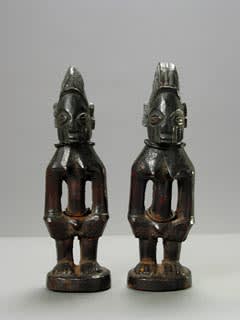Pair of Yoruba Ibeji Twin Sculptures, 20th Century CE
Wood and Glass Beads
10.25
PF.6306 (LSO)
Further images
This matched pair of darkly-patinated figures represents one of Africa’s most enduring and charming sculptural traditions. They were carved by a diviner of the Yoruba group, at the request of...
This matched pair of darkly-patinated figures represents one of Africa’s most enduring and charming sculptural traditions. They were carved by a diviner of the Yoruba group, at the request of a mother mourning the loss of her twins. The notion is based around the concept of bargaining with spirits; single figures were made to save the life of the remaining twin, while pairs were made to ensure that the dead individuals not be forgotten. They are very unusual in being ambiguous in terms of sex – these figures are usually very clearly male or female – in possessing breasts and a triple eminence that is presumably the male genitalia. They are, as stated, a matched pair, with a particularly dark colouring. They are carved in a cubist fashion, with block-shaped torsos, angular limbs and thick necks. Their heads are tall, narrow and crested with ornate, incised coiffures. Their eyes are in the relief coffee-bean format, with roughly-rendered nose and mouth and three very deep incised markings on each cheek. The ears resemble question marks. They each wear a necklace and a belt made up of dark glass trade beads.
Yoruba populations have the world’s highest prevalence of twinning (45/1000 live births – compared to 8/1000 in the US), and this fact has been woven into their mythology, culture and art. Twins are promulgated by Shango, and are regarded as auspicious. However, the mortality rate of twins is very high. According to Yoruba convention, twins share a single soul. If one should die, the spirits may take away the second twin as well. To avoid this, the babalawo (diviner) carves a figure of the same sex as the deceased child: this figure is known as an ere ibeji. The mother must wash, dress, feed and anoint the wooden figure as if it were alive. In the case of matched figures, both twins died and need to be commemorated. Similar but non-identical figures may represent works by the same artist, but for different people.
The appearance of the figures depends entirely upon the skill of the carver, as only the sex of the individual is specifically determined. The specific social history of the area, and its contacts with other areas or cultures, does determine the final appearance of the figures. For example, the hair of some individuals is rubbed with indigo dye (or paint, in this case), and the bodies with red camwood powder; specific styles and details such as scarifications betray the origin of most examples. Most ibeji are naked, but socially-elevated families often wish to manifest their wealth through dressing the figure in ornate clothing or jewellery such as trade beads.
The current pieces commemorate the dead children of a grieving family. These are attractive yet poignant works of African art.
Yoruba populations have the world’s highest prevalence of twinning (45/1000 live births – compared to 8/1000 in the US), and this fact has been woven into their mythology, culture and art. Twins are promulgated by Shango, and are regarded as auspicious. However, the mortality rate of twins is very high. According to Yoruba convention, twins share a single soul. If one should die, the spirits may take away the second twin as well. To avoid this, the babalawo (diviner) carves a figure of the same sex as the deceased child: this figure is known as an ere ibeji. The mother must wash, dress, feed and anoint the wooden figure as if it were alive. In the case of matched figures, both twins died and need to be commemorated. Similar but non-identical figures may represent works by the same artist, but for different people.
The appearance of the figures depends entirely upon the skill of the carver, as only the sex of the individual is specifically determined. The specific social history of the area, and its contacts with other areas or cultures, does determine the final appearance of the figures. For example, the hair of some individuals is rubbed with indigo dye (or paint, in this case), and the bodies with red camwood powder; specific styles and details such as scarifications betray the origin of most examples. Most ibeji are naked, but socially-elevated families often wish to manifest their wealth through dressing the figure in ornate clothing or jewellery such as trade beads.
The current pieces commemorate the dead children of a grieving family. These are attractive yet poignant works of African art.





